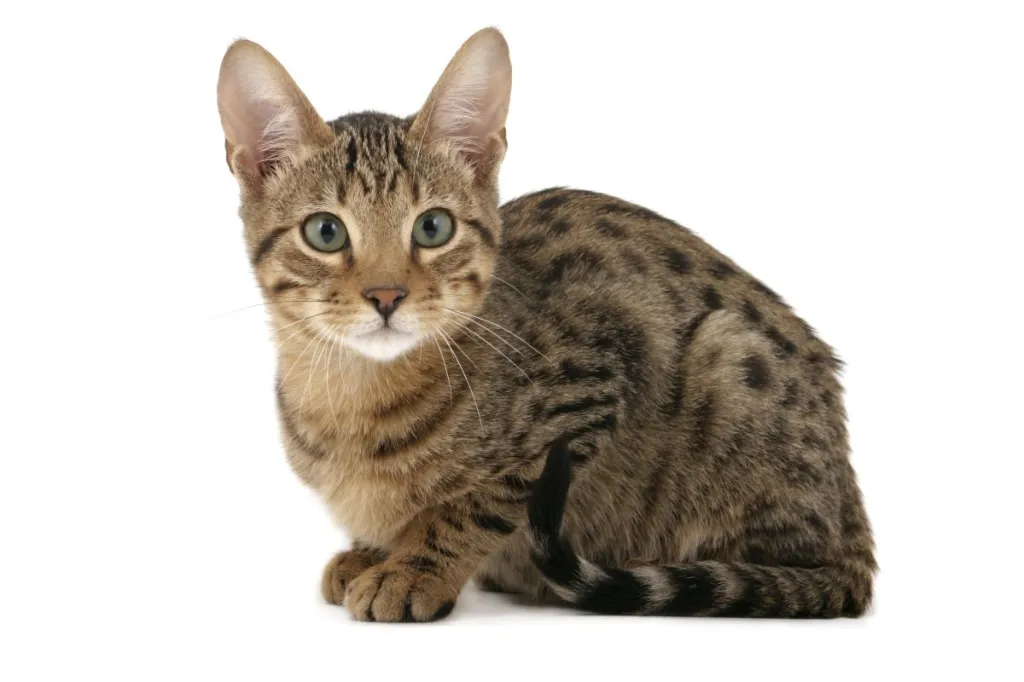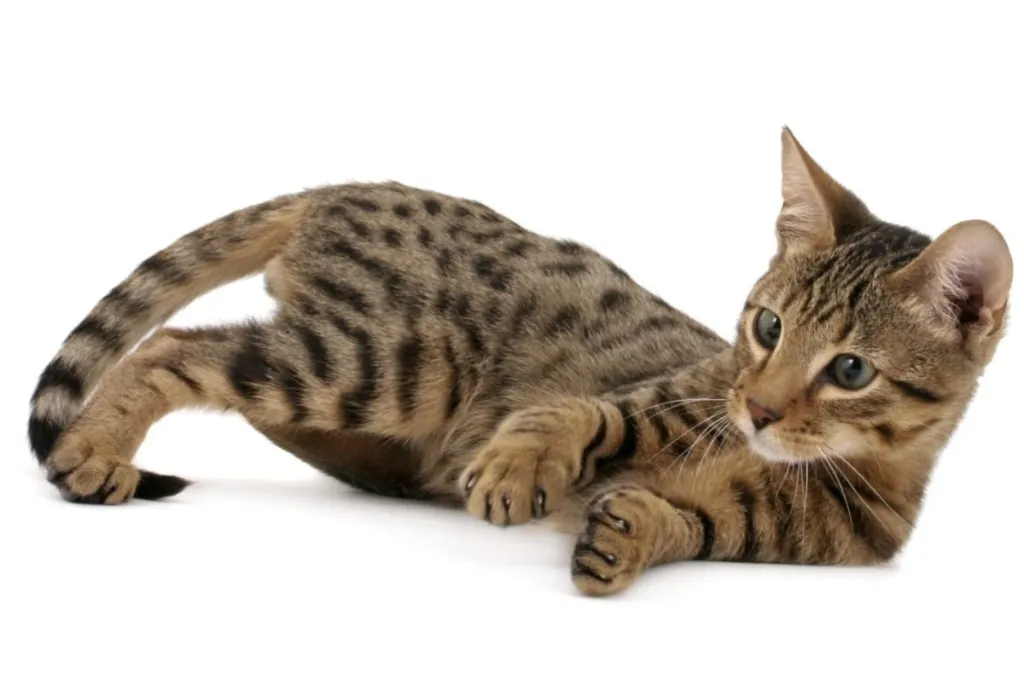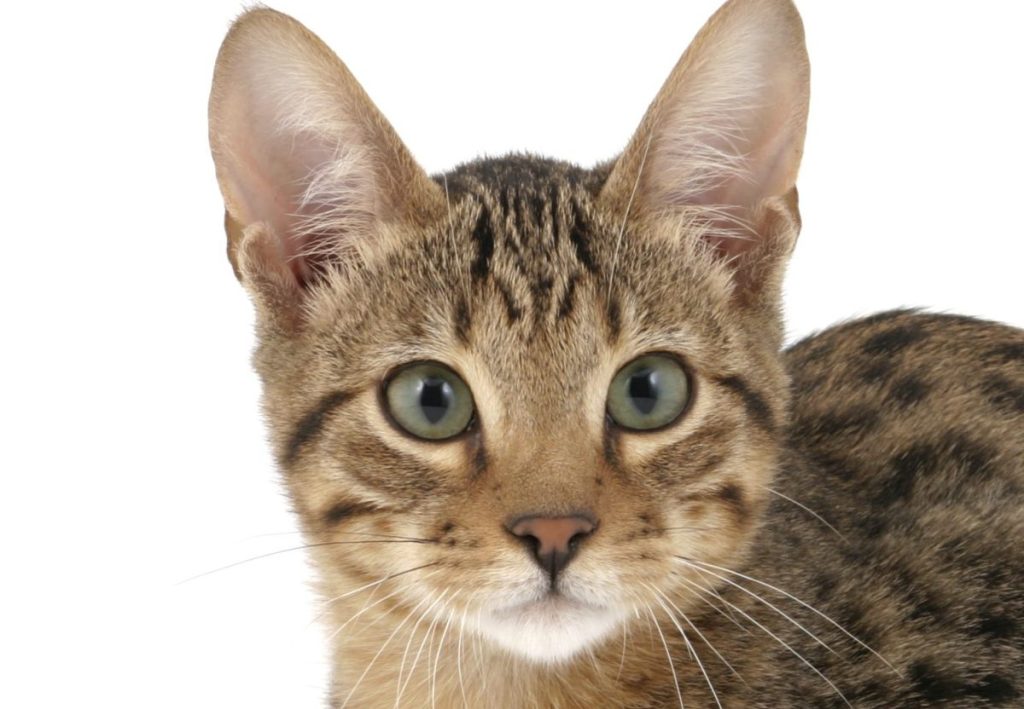The Serengeti cat is a cross between a Bengal and an Oriental Shorthair cat bred to imitate the appearance of the African Serval — but without all the bites. Recognized by The International Cat Association (TICA), Serengeti cats are medium-sized with triangular faces, long legs, big eyes, large ears, and a striking patterned coat. The lithe, elegant Serengeti cat has a lifespan of 10 to 15 years.
As expected with their Bengal parentage, the Serengeti cat is athletic and needs lots of playtime to expend energy. Their Oriental Shorthair lineage also makes them very vocal, and they will happily communicate through a unique blend of chirps, mews, and purrs. The Serengeti cat temperament is devoted, social, and playful. They form strong bonds with their favorite people and will act like a little shadow who follows you around your house. Because these cats are rare, they can also be expensive. The Serengeti cat price from a reputable breeder can range between $800 and $2000.
When considering a Serengeti, it’s advisable to prioritize adopting from rescue organizations or shelters to provide a loving home to a cat in need. However, if you decide to purchase a Serengeti kitten, it’s crucial to choose a reputable breeder. Conduct thorough research to ensure that the breeder follows ethical practices and prioritizes the well-being of their cats. Reputable Serengeti breeders prioritize the health and temperament of their cats, conduct necessary health screenings, and provide a nurturing environment for the kitties. This active approach ensures that you bring home a healthy and happy kitty while discouraging unethical breeding practices.
Serengeti Quick Facts
- Origin: United States
- Size: Medium
- Breed Group: Domestic Shorthair
- Lifespan: 10-15 years
- Coat: Short, dense, and sleek, with a distinctive spotted pattern
- Temperament: Intelligent, playful, and affectionate
- Exercise Needs: High
- Training: Easy to train
- Grooming: Weekly brushing
- Health: Generally healthy, but can develop certain genetic health conditions, such as hypertrophic cardiomyopathy (HCM) and polycystic kidney disease (PKD)
- Some Serengeti cats can have “ghost markings,” where stripes or dots can faintly show on solid colors.
- The Serengeti cat was created by biologist Karen Sausman to breed a cat that looks like the wild Serval but is purely domesticated.
- The Serengeti’s ears are as long as the entire head. This is a unique trait they’ve inherited from their Oriental Shorthair parentage.
Serengeti Cat Pictures


-
Affectionate with Family
Some cat breeds are typically independent and aloof, even if they’ve been raised by the same person since kittenhood; others bond closely to one person and are indifferent to everyone else; and some shower the whole family with affection. Breed isn’t the only factor that goes into affection levels; cats who were raised inside a home with people around feel more comfortable with humans and bond more easily.

See Cats Less Affectionate with Family -
Amount of Shedding
If you’re going to share your home with a cat, you’ll need to deal with some level of cat hair on your clothes and in your house. However, shedding does vary among the breeds. If you’re a neatnik, you’ll need to either pick a low-shedding breed or relax your standards. This furniture cover can make it easier to clean up cat hair and keep it off your sofa!
-
General Health
Due to poor breeding practices, some breeds are prone to certain genetic health problems. This doesn’t mean that every cat of that breed will develop those diseases; it just means that they’re at an increased risk. If you’re looking only for purebred cats or kittens, it’s a good idea to find out which genetic illnesses are common to the breed you’re interested in.
-
Potential for Playfulness
Some cats are perpetual kittens—full of energy and mischief—while others are more serious and sedate. Although a playful kitten sounds endearing, consider how many games of chase the mouse-toy you want to play each day, and whether you have kids or other animals who can stand in as playmates. A classic wand cat toy like this one is perfect for playful felines!
-
Tendency to Vocalize
Some breeds sound off more often than others with meows, yowls, and chattering. When choosing a breed, think about how the cat vocalizes and how often. If constant “conversation” drives you crazy, consider a kitty less likely to chat.
-
Kid-Friendly
Being tolerant of children, sturdy enough to handle the heavy-handed pets and hugs they can dish out, and having a nonchalant attitude toward running, screaming youngsters are all traits that make a kid-friendly cat. Our ratings are generalizations, and they’re not a guarantee of how any breed or individual cat will behave; cats from any breed can be good with children based on their past experiences and personality.
-
Friendly Toward Strangers
Stranger-friendly cats will greet guests with a curious glance or a playful approach; others are shy or indifferent, perhaps even hiding under furniture or skedaddling to another room. However, no matter what the breed, a cat who was exposed to lots of different types, ages, sizes, and shapes of people as a kitten will respond better to strangers as an adult.
-
Easy to Groom
Some breeds require very little in the way of grooming; others require regular brushing to stay clean and healthy. Consider whether you have the time and patience for a cat who needs daily brushing. You should definitely pick up this awesome de-shedding tool for cats of any hair length!
-
Intelligence
Some cat breeds are reputed to be smarter than others. But all cats, if deprived the mental stimulation they need, will make their own busy work. Interactive cat toys are a good way to give a cat a brain workout and keep them out of mischief. This scratcher cat toy can keep your smart kitty busy even when you’re not home!
-
Pet Friendly
Friendliness toward other household animals and friendliness toward humans are two completely different things. Some cats are more likely than others to be accepting of other pets in the home.
Serengeti Cat History
The Serengeti was originally developed back in the 1990s by Karen Sausman, a biologist and the owner of the Kingsmark Cattery who was attempting to breed a new cat who would look and act like the Serval wild cat, which resides in Africa.
The introduction of the Serengeti was intended to help bring awareness to wildlife conservation issues. The Serengeti is officially recognized by the International Cat Association (TICA).
Serengeti Cat Size
The Serengeti is a medium-sized cat breed. As is always the case, exact size standards might vary. Most Serengetis weigh somewhere between eight and 15 pounds. That said, many can be smaller or larger than average.
Serengeti Cat Personality
When it comes to summing up the Serengeti’s personality, the first thing most people notice is just how active and agile these cats are! Befitting the breed’s spiritual wild cat ancestry, the Serengeti is exceptionally athletic and loves to spend time climbing up cat trees and furniture, often perching at the top and watching the world around them go by.
It goes without saying that you’ll need to provide a suitably spacious and varied environment for the Serengeti to live in, and be warned: They love to dart around the home at high speed! Beyond the Serengeti’s spirited and energetic nature, they have proved themselves to be a loving breed of cat who forms very strong bonds with the humans they live with. In fact, it’s not uncommon for a Serengeti to always follow their humans around! The Serengeti is also a very vocal cat who will happily chat away to their humans.
Serengeti Cat Health
Serengetis are generally considered to be healthy cats–although it’s important to schedule regular wellness visits with your cat’s vet. There aren’t any breed-specific health problems associated with the Serengeti, but always keep an eye out for signs that your cat might be in distress or pain.
Serengeti Cat Care
As with all cats, it’s important to keep up your Serengeti’s regular veterinary checkups to detect any health concerns early. Your vet can help you develop a care routine that will keep your cat healthy. On a day-to-day basis, it cannot be stressed enough how important it is that your Serengeti is given enough space to run around and climb. This is essential to keeping the breed both healthy and in good spirits. Otherwise, feline obesity and a sense of frustration at being bored might become an issue. Also, add interactive toys to the home environment to keep this curious kitty mentally satisfied.
Along with scheduling yearly wellness vet visits, your Serengeti will need to have their nails checked and trimmed regularly. If you’re new to cat adoption, your vet can show you the safest way to carry this out. Adding a scratching post to your living environment can also help promote healthy scratching and keep the cat’s nails in good condition. Beyond nail care, examine the Serengeti’s ears for signs of dirt building up or possible infection every few weeks. It’s also advisable to talk with your vet about starting a regular teeth brushing regimen that will suit your Serengeti.
Serengeti Cat Coat Color And Grooming
The Serengeti’s coat is usually seen in either golden or gray colors, but always with its eye-catching leopard-style spots and markings. When it comes to grooming, the Serengeti is a low-maintenance feline. Its short and silky coat can be brushed once a week. Doing so will not only help ward off the chance of any mats forming, but also keep the coat in clean and healthy condition. Maintaining a regular brushing routine also helps to lessen the likelihood that hairballs will be an issue for the feline.
When it comes to climate, the Serengeti is generally seen as an adaptable cat that can usually live happily in most climates, although they prefer slightly warmer temperatures. Just remember to always make sure adequate shade and fresh water is provided when the temperature spikes.
Children And Other Pets
The Serengeti is an excellent cat to bring into your home if you already have children, not least because they’re a high energy and friendly feline. Just be sure that early socialization takes place and boundaries are properly set on both sides–and supervise early interactions between kids and cats.
When it comes to other household pets, the Serengeti is usually okay living alongside other domestic animals. Although you’ll want to supervise early interactions between the new cat and existing pets. Ultimately, early socialization really pays off with this breed. Make sure to reward your Serengeti for good behavior when you bring them home to your family!
Serengeti Cat Rescue Groups
It may be hard to find a breed specific rescue for Serengeti cats because they are a somewhat rare mixed breed. However, you may want to try Bengal or Oriental Shorthair breed specific rescues, as they sometimes care for breed mixes. You may also try shelters and rescues that cater to all types of cats, including Serengeti cats, as well as your local shelter. Here are some nonprofit rescues you can try:
More Info For You
If you’re also looking for a dog, check out DogTime’s dog breed page!





